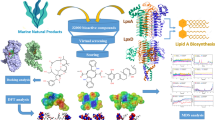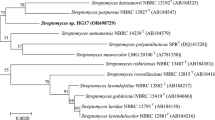Abstract—
The aim of the study was screening of chemical compounds library to find “quorum sensing” modulators in proteobacteria. The library included 19 molecules that contained the N-hexanamide non-polar radical or the 2H-1,3-benzodioxole polar heterocyclic group, which were partially identical to the natural autoinductor N-hexanoyl homoserine lactone (C6-AHL) chemical structure. The Chromobacterium violaceum CV026 (NCTC 13278) was used in “quorum sensing” modulation biotests. This biosensor strain is defective in the natural autoinducer C6-AHL biosynthesis, but contains the functional homodimeric protein CviR, which, after two C6-AHL molecules reception, activates the previously silent genes transcription, including the vioABCDE operon, which leads to the production of the blue-violet pigment violacein. The direct screening showed agonistic (violacein-inducing) activity in 4 compounds and the screening variant in presence of exogenously introduced C6-AHL indicated the antagonistic (violacein-inhibiting) activity in 9 tested compounds. Interestingly, the most pronounced antagonistic activity was found in molecules that proved to be C6-AHL agonists. Significantly, the effective concentrations of these compounds required for 50% violacein inhibition were 3.2–20.4-fold lower than ones causing 50% violacein induction. In addition, the absolute concentrations of the active compounds necessary for the induction of violacein were much higher than that of a natural autoinducer, and the degree of their inhibitory effect was inversely related to the concentration of C6-AHL exogenously introduced into the biotest. According to the screening results, N-1,3-benzodioxol-5-yl-oxohexanamide was identified as the most effective “quorum sensing” modulator, submitted for further in silico, in vitro and in vivo studies.


Similar content being viewed by others
REFERENCES
Anand, R., Rai, N., and Thattai, M., Interactions among quorum sensing inhibitors, PLoS One, 2013, vol. 8, article e62254.
Bassler, B.L. and Losick, R., Bacterially speaking, Cell, 2006, vol. 125, pp. 237–246.
Blosser, R.S. and Gray, K.M., Extraction of violacein from Chromobacterium violaceum provides a new quantitative bioassay for N-acyl homoserine lactone autoinducers, J. Microbiol. Methods, 2000, vol. 40, pp. 47–55.
Case, R.J., Labbate, M., and Kjelleberg, S., AHL-driven quorum-sensing circuits: their frequency and function among the Proteobacteria,ISME J., 2008, vol. 2, pp. 345–349.
Chen, G., Swem, L.R., Swem, D.L., Stauff, D.L., O’Loughlin, C.T., Jeffrey, P.D., Bassler, B.L., and Hughson, F.M., A strategy for antagonizing quorum sensing, Mol. Cell, 2011, vol. 42, pp. 199–209.
Chen, X., Zhang, L., Zhang, M., Liu, H., Lu, P., and Lin, K., Quorum sensing inhibitors: a patent review (2014–2018), Expert Opin. Ther. Pat., 2018, vol. 28, pp. 849–865.
Fong, J., Mortensen, K.T., Nørskov, A., Qvortrup, K., Yang, L., Tan, C.H., Nielsen, T.E., and Givskov, M., Itaconimides as novel quorum sensing inhibitors of Pseudomonas aeruginosa,Front. Cell Infect. Microbiol., 2019, vol. 8, p. 443.
Galloway, W.R., Hodgkinson, J.T, Bowden, S., Welch, M., and Spring, D.R., Applications of small molecule activators and inhibitors of quorum sensing in Gram-negative bacteria, Trends Microbiol., 2012, vol. 20, pp. 449–458.
Geske, G.D., O’Neill, J.C., and Blackwell, H.E., Expanding dialogues: from natural autoinducers to non-natural analogues that modulate quorum sensing in Gram-negative bacteria, Chem. Soc. Rev., 2008, vol. 37, pp. 1432–1447.
McClean, K.H., Winson, M.K., Fish, L., and Taylor, A., Quorum sensing and Chromobacterium violaceum: exploitation of violacein production and inhibition for the detection of N-acylhomoserine lactones, Microbiology (SGM), 1997, vol. 143, pp. 3703–3711.
Moore, J.D., Rossi, F.M., Welsh, M.A., Nyffeler, K.E., and Blackwell, H.E., A comparative analysis of synthetic Quorum Sensing modulators in Pseudomonas aeruginosa: new insights into mechanism, active efflux susceptibility, phenotypic response, and next-generation ligand design, J. Am. Chem. Soc., 2015, vol. 137, pp. 14626–14639.
Papenfort, K. and Bassler, B.L., Quorum sensing signal-response systems in Gram-negative bacteria, Nat. Rev. Microbiol., 2016, vol. 14, pp. 576–588.
Ravithej Singh, L., Tripathi, V.C., Raj, S., Kumar, A., Gupta, S., Horam, S., Upadhyay, A., Kushwaha, P., Arockiaraj, J., Sashidhara, K.V., and Pasupuleti, M., In-house chemical library repurposing: a case example for Pseudomonas aeruginosa antibiofilm activity and quorum sensing inhibition, Drug Dev. Res., 2018, vol. 79, pp. 383–390.
Rémy, B., Mion, S., Plener, L., Elias, M., Chabrière, E., and Daudé, D., Interference in bacterial Quorum Sensing: a biopharmaceutical perspective, Front. Pharmacol., 2018, vol. 9, p. 203.
Sanchez, C., Brana, A.F., Mendez, C., and Salas, J.A., Reevaluation of the violacein biosynthetic pathway and its relationship to indolocarbazole biosynthesis, Chembiochem., 2006, vol. 7, pp. 1231–1240.
Stauff, D.L. and Bassler, B.L., Quorum Sensing in Chromobacterium violaceum: DNA recognition and gene regulation by the CviR receptor, J. Bacteriol., 2011, vol. 193, pp. 3871–3878.
von Bodman, S.B., Willey, J.M., and Diggle, S.P., Cell-cell communication in bacteria: united we stand, J. Bacteriol., 2008, vol. 190, pp. 4377–4391.
Welsh, M.A. and Blackwell, H.E., Chemical probes of quorum sensing: from compound development to biological discovery, FEMS Microbiol. Rev., 2016, vol. 40, pp. 774–794.
Zhang, R.G., Pappas, K.M., Brace, J.L., Miller, P.C., Oulmassov, T., Molyneaux, J.M., Anderson, J.C., Bashkin, J.K., Winans, S.C., and Joachimiak, A., Structure of a bacterial quorum-sensing transcription factor complexed with pheromone and DNA, Nature, 2002, vol. 417, pp. 971–974.
Funding
The work was supported by the Russian Science Foundation, project no. 16-16-10048.
Author information
Authors and Affiliations
Corresponding author
Ethics declarations
The authors declare that they have no conflict of interest. This article does not contain any studies involving animals or human participants performed by any of the authors.
Additional information
Translated by P. Sigalevich
Rights and permissions
About this article
Cite this article
Deryabin, D.G., Galadzhieva, A.A. & Duskaev, G.K. Screening of N-Hexanamide and 2H-1,3-Benzodioxol Derivatives for Quorum Sensing Modulation in Chromobacterium violaceum . Microbiology 89, 733–739 (2020). https://doi.org/10.1134/S0026261720050069
Received:
Revised:
Accepted:
Published:
Issue Date:
DOI: https://doi.org/10.1134/S0026261720050069




